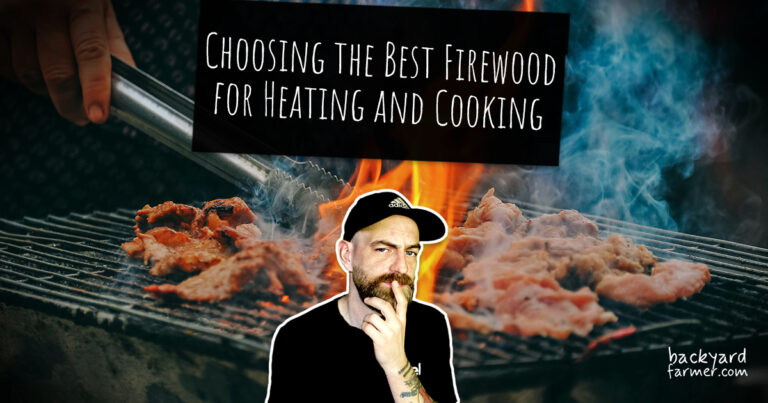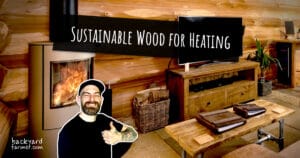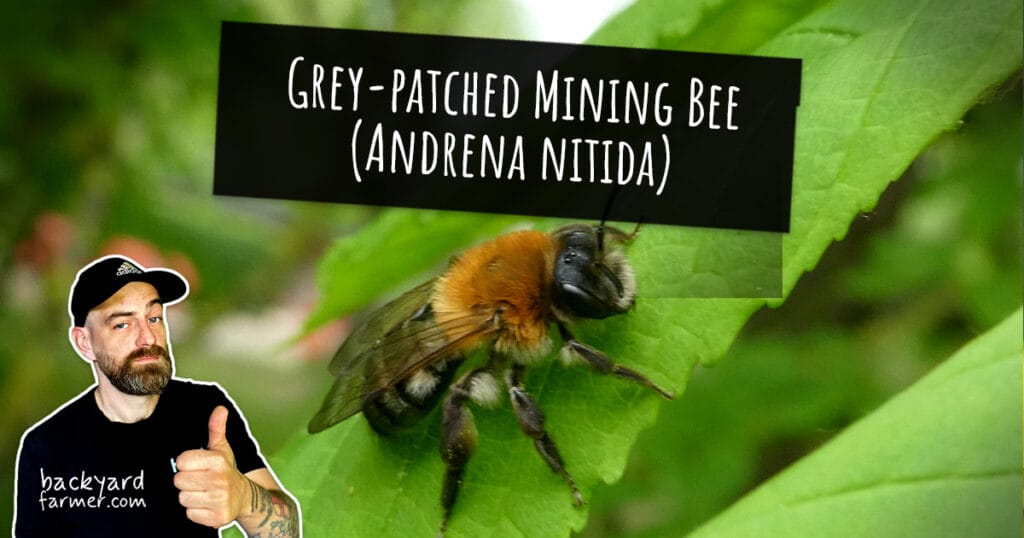Table of contents
Introduction
Not all firewood is created equal. The wood you burn can affect everything — from how warm your home feels to how your pizza tastes. So, how do you choose the best firewood for heating and cooking?
Whether you’re firing up a log burner to stay cosy through winter or adding smoky flavour to food with a pizza oven or BBQ, the right wood makes a real difference. Some logs burn hot and slow. Others catch quickly but fizzle fast. And some types are perfect for cooking thanks to the flavour-rich smoke they produce.
What You’ll Learn
In this guide, you’ll learn:
- Which firewoods burn the hottest and last the longest
- The difference between hardwood and softwood (and when to use each)
- How BTU ratings and moisture levels impact performance
- Where to find the best firewood near you
Find Firewood Fast
Looking for a shortcut? Try our free Firewood Finder tool to locate top-quality logs in your area.
Burn Smarter
Whether you’re chopping your own logs, stacking seasoned oak, or just want the best wood for your next cookout — this guide will help you burn smarter.
Let’s dive in.
What Makes Firewood “The Best”?
When it comes to heating and cooking, not all logs are created equal. The best firewood burns hot, lasts longer, and produces minimal smoke. So, what makes the best firewood for heating and cooking stand out from the rest? Let’s break it down:
1. BTU Ratings (Heat Output)
BTU stands for British Thermal Unit — it measures how much heat a log gives off. Hardwoods like oak, ash, and beech have high BTU ratings, so they burn hotter and last longer. On the other hand, low-BTU woods like pine burn fast and need constant refuelling.
Quick Tip: Use BTU charts to compare heat efficiency before you buy.
2. Moisture Content
Moisture content plays a huge role in how well your firewood performs. Aim for logs with less than 20% moisture — either well-seasoned or kiln-dried. Wet wood produces excess smoke, clogs your chimney with creosote, and wastes heat. A moisture meter is a simple way to check if your firewood is ready to burn.
3. Burn Time and Density
The denser the wood, the longer it burns. Hardwoods like hornbeam and oak are perfect for steady, overnight heating. Softer woods like spruce and poplar burn faster, making them better for kindling or short fires.
4. Clean Burn and Smoke Production
Great firewood burns cleanly with few sparks and little smoke. This not only helps your chimney stay cleaner but also keeps your indoor air fresher — especially if you’re using a wood-burning stove or fireplace.
Burn Smarter with the Right Firewood
By choosing firewood based on these qualities, you’ll get a more efficient, reliable, and eco-friendly burn every time — and maximise your firewood efficiency.
Looking for high-BTU firewood nearby? Try the Firewood Finder tool to discover seasoned hardwood suppliers in your area.
Hardwood vs. Softwood – What’s the Difference?
If you’ve ever shopped for firewood, chances are someone told you to “go with hardwood.” But what makes it better? Let’s break down the key differences between hardwood and softwood so you can choose the right logs for your setup. This quick firewood comparison will help you decide which is best for your needs.
Quick Comparison Table
| Feature | Hardwood | Softwood |
| Density | High (heavier) | Lower (lighter) |
| Burn Time | Long and steady | Quick-burning |
| Heat Output (BTU) | High | Lower |
| Sparks/Crackle | Minimal | Often more sparks |
| Smoke | Less (when seasoned) | Can produce more smoke |
| Best Use | Heating, cooking | Kindling, outdoor fires |
Hardwood: The Long Burner
Hardwood comes from deciduous trees like oak, ash, and beech. Thanks to its density, it burns slowly, generates strong heat, and leaves behind glowing embers. This makes it perfect for warming your home or keeping a steady temperature while cooking.
Softwood: The Quick Igniter
Softwood, from coniferous trees like pine and spruce, is lighter and less dense. It catches fire easily and burns fast, which makes it ideal for kindling. However, it tends to spark more and produce extra smoke, so it’s not great for long indoor burns.
Pro Tip: Mix for Best Results
Start your fire with softwood for a quick flame, then switch to hardwood for a long, efficient burn. For the best firewood for heating, hardwoods like oak and ash outperform softwoods thanks to their higher density and longer burn times.
By understanding the difference between hardwood and softwood, you’ll burn smarter — whether you’re heating a cabin or roasting veggies in a backyard oven.
Best Firewood Types for Heating
When it comes to keeping your home warm, not all wood gets the job done equally well. High-density hardwoods are the go-to choice for long-lasting heat, steady flames, and a cleaner burn. Here are some of the best firewood types for heating in the UK, including top-performing hardwoods with high BTU ratings.
When cooking with wood, remember to check the firewood storage and preparation guide so your logs burn cleanly.
Top UK Hardwoods for Heating
| Wood Type | BTU Rating (approx.) | Burn Quality | Seasoning Time | Notes |
| Oak | Very High | Long, slow burn | Long (18–24 months) | Must be well-seasoned to reduce smoke |
| Ash | High | Steady, easy to light | Medium (12–18 months) | Can be burned slightly green if needed |
| Hornbeam | Very High | Slow, intense heat | Long (18–24 months) | Very dense and clean-burning |
| Beech | High | Bright, steady flame | Long (18–24 months) | Burns best when fully seasoned |
| Birch | Medium-High | Quick to catch | Short (6–12 months) | Great for mixing with denser hardwoods |
Why Hardwoods Work Best for Heating
- Higher BTU ratings mean each log puts out more heat
- Slower, more even burns are perfect for overnight or all-day fires
- Less creosote and smoke helps keep your chimney cleaner and your air healthier
Pro Tip: Mix and match your stash — use ash to get your fire going quickly, then add oak to keep it burning through the night. For the best firewood for heating, stick with dense UK hardwoods that deliver reliable warmth.
Find the Right Firewood Fast
If you’re collecting your own firewood, make sure to give it enough time to season. Or, for a shortcut, use our Firewood Finder tool to locate kiln-dried hardwood near you.
If you’re searching for the best firewood UK suppliers, the Firewood Finder can also help you compare prices and wood types in your area.
👉 Also read: How to Season and Store Firewood Properly
Best Firewood Types for Cooking
When it comes to cooking with firewood, flavour is just as important as heat. The right wood can elevate your meals with subtle, smoky notes, while the wrong one can make food taste bitter or overly smoky.
Let’s break down the best firewood for cooking, including top options for outdoor grills, pizza ovens, and smokers. Explore the best firewood types for pizza ovens and fireplaces if you’re cooking or heating at home.
Fruitwoods for Flavour
Fruitwoods burn cleanly and deliver sweet, mild aromas that enhance a variety of dishes. They’re especially popular for smokers, pizza ovens, and open-flame grilling.
- Apple – Offers a sweet, mellow smoke that’s perfect for pork, poultry, and baked dishes.
- Cherry – Adds a rich, slightly tart flavour — ideal for red meats and vegetables.
- Pear – Delivers a mild, sweet smoke that works well with white meats and cheeses.
Hardwood Staples for Heat and Burn Time
If you need long-lasting heat for cooking over time, these hardwoods are your best bet:
- Oak – Burns hot and steady; a solid all-rounder for cooking any meat.
- Beech – Produces bright flames with neutral smoke; great for baking breads and pizzas.
- Maple – Provides a mildly sweet smoke; pairs nicely with bacon, ham, and ribs.
Woods to Avoid for Cooking
Skip these if you want clean, consistent results:
- Pine, spruce, or other softwoods – Too resinous, often creating acrid smoke and soot.
- Green or unseasoned wood – Burns unevenly and produces bitter-tasting smoke.
- Treated or painted wood – Contains chemicals that are unsafe for cooking.
Pro Tip for Perfect Cooking Fires
Mix hardwoods for heat and fruitwoods for flavour. Always make sure your firewood is properly seasoned to avoid overpowering your food.
Need top-quality cooking wood? Use our Firewood Finder tool to locate kiln-dried cherry, apple, and oak — some of the best firewood for cooking available near you.
For more off-grid cooking ideas, see the DIY solar food dehydrator project.
Where to Buy or Source the Best Firewood
Finding high-quality firewood doesn’t have to be difficult. Whether you’re after local, sustainable logs or a bulk delivery of kiln-dried hardwood, there are several reliable ways to stock up — as long as you know what to look for. With the right approach, you can always find the best firewood UK options that fit your needs.
Top Tips for Buying Firewood
- Check for ‘Ready to Burn’ certification: This label means the logs have a moisture content below 20% — perfect for clean, efficient burning.
- Know the difference between kiln-dried and seasoned: Kiln-dried wood burns hotter and cleaner, while seasoned logs can be great if they’ve been stored properly.
- Ask about the wood species: Choose oak, ash, or beech for heating. For cooking, go with fruitwoods or clean-burning hardwoods.
- Avoid mystery log bundles: Mixed or unlabelled firewood may contain damp, low-BTU species that won’t perform well.
Where to Find Quality Firewood
1. Local Suppliers
Start by checking with local tree surgeons, firewood merchants, or farm shops. Always ask if the wood has been seasoned or kiln-dried.
2. Online Retailers
Trusted UK brands like Lekto Woodfuels and LogsOnline sell pre-packaged hardwood bundles with clear product info, customer reviews, and nationwide delivery. Many offer cheap firewood delivery UK-wide, often with next-day options. Watch for bulk deals if you’re buying in quantity.
3. Your Own Land or Garden
If you’ve got access to trees, you can collect and season your own wood from windfalls or managed cuttings. Just be sure to follow local regulations before cutting anything down.
Use the Firewood Finder Tool
Don’t feel like searching around? Use our free Firewood Finder to instantly find the best local suppliers near you. Filter by wood type, delivery options, and supplier rating — and get straight to the good stuff. You can even compare prices and find logs for sale near you, making it the best place to buy firewood with confidence.
Affiliate Tip: This is a great spot to feature kiln-dried oak, ash, or cherry bundles with ‘Buy Now’ buttons linking to your trusted partners.
With the right supplier, you’ll enjoy better burns, less hassle, and peace of mind knowing you’re getting top-quality logs.
Frequently Asked Questions (FAQ)
Still have questions about choosing the right firewood? You’re not alone. Here are some of the most common things people ask when they’re trying to heat their home or cook outdoors more efficiently.
Answer: Hornbeam and oak are two of the hottest-burning hardwoods available in the UK. Thanks to their high BTU ratings and dense makeup, they burn slow and hot — perfect for keeping your home warm through the coldest nights. They’re also considered some of the best firewood for heating overall.
Answer: Ash is a standout option. It lights easily, burns clean, and delivers steady heat with minimal smoke. Beech and birch are also solid choices, especially if they’ve been properly seasoned.
Answer: Technically, yes — but it’s not ideal. Softwoods burn quickly and produce more sap and smoke, which can lead to creosote buildup in your chimney or leave an off taste in your food. They’re best reserved for kindling or outdoor fire pits.
Answer: In many cases, yes. Kiln-dried wood has lower moisture content and is ready to burn straight away. It’s a cleaner, more consistent option — especially if you’re using it indoors or want a reliable heat source.
Answer: Absolutely — if you’ve got the space and patience. Fast-growing trees like willow or poplar work well for kindling, while oak, ash, and hornbeam are excellent for long-term heat. Keep an eye out for our guide on Best Trees to Grow for Firewood in the UK.
Still Have Questions?
If your question isn’t listed here, don’t worry — the Firewood Finder tool is a great place to start. It helps you pinpoint the best firewood near you in the UK based on your needs, location, and what you’re burning it for.
Conclusion
Choosing the best firewood for heating and cooking doesn’t have to be complicated — it just takes a bit of know-how. Once you understand the difference between wood types and what makes each one burn better, you’ll save time, money, and energy.
Quick Recap
- Hardwoods like oak, ash, and hornbeam burn hotter, longer, and cleaner — ideal if you’re after the best firewood for heating your home.
- Fruitwoods such as apple and cherry add delicious flavour to food, making them perfect for cooking.
- Moisture matters — always choose logs with less than 20% moisture content.
- Check BTU ratings to compare the heat output of different firewood types.
Find the Best Firewood Near You
Ready to stock up? Use our free Firewood Finder tool to locate seasoned or kiln-dried logs near you. It’s the easiest way to find the best firewood near you in the UK, whether you’re heating your home or firing up a pizza oven.
Explore More Firewood Guides
👉 Want more tips? Dive into other helpful guides from our firewood series:
- How to Season and Store Firewood Properly
- Free or Cheap Firewood: Legal Tips and Tricks
- How to find Free Firewood ‘near me’
- Tools for Cutting, Splitting, and Transporting Firewood
With the right firewood, you’ll burn less, cook better, and stay warmer — all season long.






